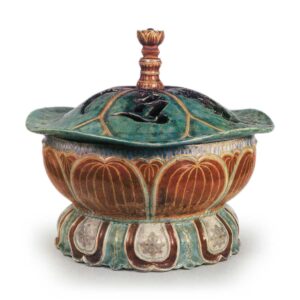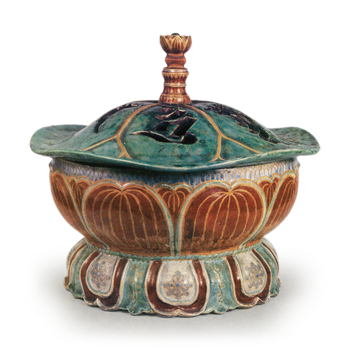
Incense burner with lotus flower in overglaze enamels
Important Cultural Property
Height 26.4 cm, mouth diameter 24.2 cm, bottom diameter 20.2 cm
This piece was once designated as a National Treasure by Hokkeongin as it was made by Den-ninsei and is now an Important Cultural Property. However, after having held a number of pieces by Ninsei, I have observed that this piece was probably made in the kiln of Ninsei Omuroyaki in various respects, such as the taste of the clay, the overglaze enameling, and the generosity of the workmanship. According to an anecdote, this incense burner was discovered in a night stall in 1872 by the head of Hokkongo Temple, and was later designated a national treasure by Hisanari Machida, the director of the Imperial Household Museum.
The body has eight lotus petals, and the base is also covered with eight lotus petals with a rim of lotus leaves. In the center of the lid are knob knobs with a vajra handle with a lotus seed on the tip, and on the five sides of the lid are Brahma characters engraved in openwork as a smoke outlet.
The double-petaled lotus petals on the body are represented in red and wrapped with gold lines. The style is the same as that of the “tea jar with mustard design in overglaze enamels,” which is not very skillful, but the design of the lotus petals blends well with the generous overall shape.
The clay is soft white, and the inside of the body is covered with a cloudy white glaze, while the back of the base is exposed and the back of the lid is covered with a cloudy white glaze. The entire surface of the lotus leaf-shaped lid is covered with green overglaze paint, giving it an apparent kotsuji ware look.
Since shards similar to this lotus leaf were excavated from the Insei kiln site, it seems safe to say that it was made by the Insei kiln, and is probably an early example of colored pottery from Omuro ware.



